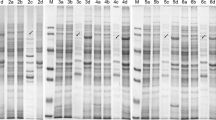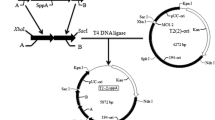Abstract
A chimeric gene mHG (669 bp) was constructed by substitution of Clostridium thermocellum ZJL4 lichenase (CG) N-terminal fragment (except its signal sequence) for the counterpart of Bacillus sp. A3 lichenase (BG). To acquire high-level secretion of the chimeric lichenase (mHG) in Bacillus subtilis, a series of site-mutated signal peptides were designed. The activity of mHG, which was directed by an artificial hydrophobic signal peptide H1 (MMARKIAGMATSLLVIFSSSAVA) from cytoplasm into growth medium, reached 80.56 U/ml after 22-h incubation, indicating that signal peptide hydrophobicity appears to be critical for early stages in mHG export. By purification of the mHG (∼25.3 kDa) from cultures of B. subtilis (pBSG-H1), enzymatic property assays showed that the common optima for mHG were 70°C and pH 5.0. The residual activity of mHG at 90°C for 10 min was 83.45% of its maximum activity, which was almost similar to that of CG (90°C, 10 min, 84.33%). This constructed shuttle expression vector with a novel signal peptide exhibited its applicability for high-level production of heterologous proteins from B. subtilis. Moreover, the high-level secreted mHG with relatively high thermostability could be a potential candidate for feed industrial applications.


Similar content being viewed by others
References
Antelmann H, Tjalsma H, Voigt B, Ohlmeier S, Bron S, van Dijl JM, et al. (2001) A proteomic view on genome-based signal peptide predictions. Genome Res 11:1484–1502
Borriss R, Olsen O, Thomsen KK, von Wettstein D (1989) Hybrid bacillus endo-(1-3,1-4)-beta-glucanases: construction of recombinant genes and molecular properties of the gene products. Carlsberg Res Commun 54:41–54
Fu LL, Xu ZR, Li WF, Shuai JB, Lu P, Hu CX (2007) Protein secretion pathways in Bacillus subtilis: implication for optimization of heterologous protein secretion. Biotechnol Adv 25:1–12
Ganesh C, Banerjee A, Shah A, Varadarajan R (1999) Disordered N-terminal residues affect the folding thermodynamics and kinetics of maltose binding protein. FEBS Lett 454: 307–311
Horton RM, Hunt HD, Ho SN, Pullen JK, Pease LR (1989) Engineering hybrid genes without the use of restriction enzymes: gene splicing-by-overlap extension. Gene 77:61–68
Li WF, Zhou XX, Lu P (2004) Bottlenecks in the expression and secretion of heterologous proteins in Bacillus subtilis. Res Microbiol 155:605–610
Miller GL (1959) Use of dinitrosalicylic acid reagent for determination of reducing sugar. Anal Chem 31:26–428
Nguyen HD, Phuong Phan TT, Schumann W (2007) Expression vectors for the rapid purification of recombinant proteins in Bacillus subtilis. Curr Microbiol 55:89–93
Olsen O, Borriss R, Simon O, Thomsen KK (1991) Hybrid Bacillus (1-3,1-4)-beta-glucanases: engineering thermostable enzymes by construction of hybrid genes. Mol Gen Genet 225:177–185
Planas A (2000) Bacterial 1,3-1,4-β-glucanases: structure, function and protein engineering. Biochim Biophys Acta 1543:361–382
Politz O, Simon O, Olsen O, Borriss R (1993) Determinants for the enhanced thermostability of hybrid (1-3,1-4)-beta-glucanases. Eur J Biochem 216:829–834
Salih ME, Classen HL, Campbell GL (1991) Response of chickens fed on hull-less barley to dietary β-glucanase at different ages. Anim Feed Sci Technol 33:139–149
Sun JY, Liu MQ, Xu YL, Xu ZR, Pan L, Gao H (2005) Improvement of the thermostability and catalytic activity of a mesophilic family 11 xylanase by N-terminus replacement. Protein Expr Purif 42:122–130
Takano K, Tsuchimori K, Yamagata Y, Yutani K (1999) Effect of foreign N-terminal residues on the conformational stability of human lysozyme. Eur J Biochem 266:675–682
Tjalsma H, Bolhuis A, Jongbloed JD, Bron S, van dijl JM (2000) Signal peptide-dependent protein transport in Bacillus subtilis: a genome-based survey of the secretome. Microbiol Mol Biol Rev 64:515–547
Welfle K, Misselwitz R, Politz O, Borriss R, Welfle H (1996) Individual amino acids in the N-terminal loop region determine the thermostability and unfolding characteristics of bacterial glucanases. Protein Sci 5:2255–2265
Welfle K, Misselwitz R, Welfle H, Simon O, Politz O, Borriss R (1994) Microcalorimetric determination of the thermostability of three hybrid (1-3,1-4)-beta-glucanases. J Biomol Struct Dyn 11:1417–1424
Weng XY, Sun JY (2005) Construction, expression, and characterization of a thermostable xylanase. Curr Microbiol 51:188–192
Xue GP, Johnson JS, Dalrymple BP (1999) High osmolarity improves the electro-transformation efficiency of the gram-positive bacteria Bacillus subtilis and Bacillus licheniformis. J Microbiol Meth 34:183–191
Zanen G, Houben EN, Meima R, Tjalsma H, Jongbloed JD, Westers H, et al. (2005) Signal peptide hydrophobicity is critical for early stages in protein export by Bacillus subtilis. FEBS J 272:4617–4630
Zhang XZ, Cui ZL, Hong Q, Li SP (2005) High-level expression and secretion of methyl parathion hydrolase in Bacillus subtilis WB800. Appl Environ Microbiol 71:4101–4103
Acknowledgments
This work was supported by grants from the Zhejiang Provincial Scientific Program of the People’s Republic of China (no. 2004C32031) and the National Natural Science Foundation of the People’s Republic of China (no. 30771579).
Author information
Authors and Affiliations
Corresponding author
Rights and permissions
About this article
Cite this article
Fu, Ll., Xu, Zr., Shuai, Jb. et al. High-Level Secretion of a Chimeric Thermostable Lichenase from Bacillus subtilis by Screening of Site-Mutated Signal Peptides with Structural Alterations. Curr Microbiol 56, 287–292 (2008). https://doi.org/10.1007/s00284-007-9077-5
Received:
Accepted:
Published:
Issue Date:
DOI: https://doi.org/10.1007/s00284-007-9077-5




